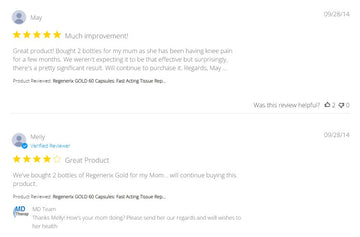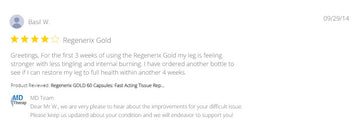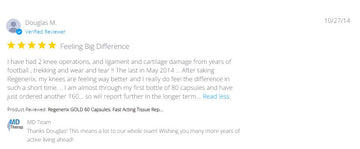Single Knee-to-Chest Stretch: A Calm Flexion Reset for Stiff Low Backs & Hips
由 MD therapeutics 上 Aug 17, 2025
Why single knee-to-chest helps (the principles)
-
Facet & capsule relief: Gentle lumbar flexion + posterior pelvic tilt can unload facet joints and posterior elements—often soothing in age-related spondylosis and posture-related low-back pain.
-
Disc/endplate fluid exchange: Slow flexion–return cycles change intradiscal pressure, encouraging fluid movement across endplates—useful for morning or desk-posture stiffness.
-
Hip capsule & glute comfort: Bringing one thigh toward the chest mobilizes the posterior hip capsule and gluteal tissues with minimal spinal load—good prep for walking and sit-to-stand.
-
Self-dosed, low load: Supine support lets you control range and breath to keep symptoms ≤3/10.
Often helpful for: nonspecific low-back pain, facet-comfort patterns, lumbar stenosis (flexion-friendly), hip stiffness.
Modify/avoid: flexion-sensitive disc herniation or new radicular symptoms—use micro-ranges or choose a neutral-spine alternative per clinician guidance.
How to do it (range-aware & comfortable)
-
Setup: Lie on your back, one leg long, the other knee bent.
-
Exhale → draw the knee gently toward your chest (hands behind thigh or over shin); keep the opposite leg relaxed and spine long.
-
Inhale → soften and return a little toward neutral.
-
Dosage: 2–3 sets × 3–5 slow breaths/side (or 6–8 slow reps), 1–2×/day.
-
Options:
-
Loop a strap behind the thigh if gripping the shin bothers the knee/hip.
-
Keep the “down” leg bent (foot on floor) for an easier back position.
-
Add a tiny pelvic tuck at the top if it feels relieving.
-
-
Pain guide: Keep pain ≤3/10 and resolve within 24 h; otherwise, shrink the range or switch drills.
Limits of exercise alone
-
Systemic drivers remain: Diet, sleep, stress, and metabolic health influence symptoms and recovery but aren’t fixed by stretching.
-
Flares cap load: Pain spikes can cause stop–start progress without broader support.
-
Specific deficits persist: Many also need hip-abductor/extensor strength, hip hinge skill, and thoracic mobility.
-
Slow tissue remodeling: Discs, tendons, and joint capsules adapt over months—consistency plus recovery and nutrition beats “exercise only.”
Why add nutritional correction
-
Improve circulation for better oxygen/nutrient delivery after sessions.
-
Promote repair with structural inputs (e.g., collagen peptides, hyaluronic acid) that your movement “signals” into tissues.
-
Reduce excessive inflammation so you can practice consistently.
-
Avoid tissue damage by buffering oxidative and catabolic stress from repeated loading.
Botanicals & nutrients often paired with joint-support programs
(Blends traditional lore with published research; evidence ranges from promising to mixed. Check interactions and personal suitability with your clinician.)
-
Ginger (Zingiber officinale): In Ayurveda/East Asian traditions for circulation and “wind-damp” aches; standardized extracts show modest symptom support for some with osteoarthritis.
-
Turmeric / Curcumin (Curcuma longa): Core Ayurvedic spice; bioavailability-enhanced curcumin has reduced knee-OA pain and improved function in multiple trials. Dietary turmeric alone has little curcumin.
-
Boswellia / Frankincense (Boswellia serrata): Ayurveda’s shallaki; standardized extracts have demonstrated improvements in pain/function in OA cohorts.
-
Winter Cherry / Ashwagandha (Withania somnifera): Adaptogen supporting resilience; clinical work suggests immunomodulatory effects and symptom support that can aid training tolerance.
-
Collagen Peptides (Type II focus): Provide peptides that may support cartilage/connective-tissue metabolism—useful alongside gentle flexion work.
-
Hyaluronic Acid (oral): Contributes to joint lubrication/viscosity; used to support comfort and smooth motion.
-
Cat’s Claw (Uncaria spp.): Amazonian lore for “rheumatism”; small trials report short-term pain improvements (evidence base still developing).
The practicality problem
-
Food-only dosing is hard: Reaching research-like intakes of curcumin/ginger via meals every day is impractical.
-
Pill burden & cost add up: Buying six–seven separate products (ginger, turmeric, boswellia, ashwagandha, collagen, HA, cat’s claw) multiplies capsules and monthly spend versus one comprehensive formula.
A convenient all-in-one option: Regenerix Gold™
Prefer knee-to-chest + nutrition without juggling bottles?
-
What’s inside: Hydrolyzed Type II Collagen, Hyaluronic Acid, and a proprietary blend of Ginger, Turmeric, Frankincense (Boswellia), Cat’s Claw, and Winter Cherry (Ashwagandha)—the same seven ingredients discussed above—combined to promote healthy joint and muscle function and support everyday recovery.
-
Dosing: 2–3 capsules daily.
-
Price: $98 a bottle.
-
Why it fits here: One product covering seven evidence-linked ingredients is simpler—and typically more cost-effective—than buying 5–7 separate supplements.
-
Track record: Recommended by doctors and physical therapists internationally for about a decade (individual clinician views vary).
Supplements support healthy function; they don’t diagnose, treat, or cure disease. Check interactions (e.g., anticoagulants with turmeric/ginger/boswellia) and suitability with your clinician.
This week’s mini-plan
-
Daily: Single knee-to-chest 2–3 sets × 3–5 slow breaths/side.
-
2–3×/wk pairings:
-
Pelvic tilts (find neutral),
-
Supine lumbar rotations (small arcs),
-
Hip-flexor & hamstring gentle stretches,
-
Glute bridges (neutral pelvis).
-
-
If symptoms spike: Reduce range by ~30–50% or switch to a supported version; re-progress once discomfort settles within 24 h.



